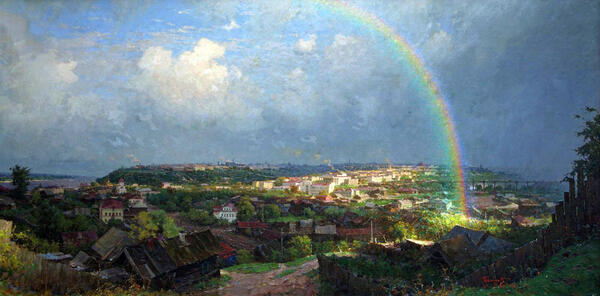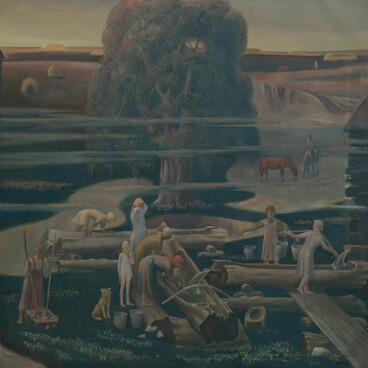“The painter of the Volga and Cheboksary” Boris Belousov was born into a peasant family in 1924 in the village of Chuvarley. He studied at the Cheboksary Art School under the teachers Nikita Kuzmich Sverchkov, Vasily Stepanovich Gurin, and Rozalia Mikhailovna Yermolaeva. Even during his student years, he impressed his mentors and peers with his subtle understanding of color. In those same years, he developed a penchant for landscape painting.
In the second half of the 1960s, Boris Belousov’s art enjoyed a heyday. He spent a lot of time working en plein air on studies for large panoramic paintings. It was during those years that he created his most recognized works — “Rainbow Over the City” and “Drift Ice on the Volga”.
“Rainbow Over the City” by Boris Belousov is a panoramic landscape, included in the list of the best works in Chuvash art. In this work, the artist depicted the expanse of Cheboksary and its surroundings near the Volga on a summer day after a severe thunderstorm. The foreground and middle ground show the old part of the city in the shade, and in the center are sunlit apartment blocks and new buildings of modern Cheboksary. The painting radiates joy at the prospect of light and revival.
The museum’s collection contains three of Belousov’s works that depict the views from the same spot — the Proletarsky ravine. The painting “Rainbow Over the City” shows how the “old city” is gradually falling into decay. The artist seems to purposely put it in the shade, directing the sunlight at the new houses springing up on Lenin Avenue instead. On the left of the canvas is the gate church of Theodore Stratelates of the Holy Trinity Monastery, and next to it is the light-colored building of the Solovtsov house. The Assumption Church is depicted without cross finials: back then, the building housed the museum of local lore. There are also merchant buildings — shops on Krasnaya Square — and the House of Communication in the constructivist style. The Chuvash Music Theater, built in 1961, becomes a new landmark. It currently houses the Chuvash Drama Theater named after Konstantin Ivanov. Further along the avenue is the tower of the Agricultural Institute, built in 1957. The right edge of the picture shows the recently opened Moscow Bridge. In the background, active construction unfolds in the area of the Cheboksary Cotton Mill.
In the second half of the 1960s, Boris Belousov’s art enjoyed a heyday. He spent a lot of time working en plein air on studies for large panoramic paintings. It was during those years that he created his most recognized works — “Rainbow Over the City” and “Drift Ice on the Volga”.
“Rainbow Over the City” by Boris Belousov is a panoramic landscape, included in the list of the best works in Chuvash art. In this work, the artist depicted the expanse of Cheboksary and its surroundings near the Volga on a summer day after a severe thunderstorm. The foreground and middle ground show the old part of the city in the shade, and in the center are sunlit apartment blocks and new buildings of modern Cheboksary. The painting radiates joy at the prospect of light and revival.
The museum’s collection contains three of Belousov’s works that depict the views from the same spot — the Proletarsky ravine. The painting “Rainbow Over the City” shows how the “old city” is gradually falling into decay. The artist seems to purposely put it in the shade, directing the sunlight at the new houses springing up on Lenin Avenue instead. On the left of the canvas is the gate church of Theodore Stratelates of the Holy Trinity Monastery, and next to it is the light-colored building of the Solovtsov house. The Assumption Church is depicted without cross finials: back then, the building housed the museum of local lore. There are also merchant buildings — shops on Krasnaya Square — and the House of Communication in the constructivist style. The Chuvash Music Theater, built in 1961, becomes a new landmark. It currently houses the Chuvash Drama Theater named after Konstantin Ivanov. Further along the avenue is the tower of the Agricultural Institute, built in 1957. The right edge of the picture shows the recently opened Moscow Bridge. In the background, active construction unfolds in the area of the Cheboksary Cotton Mill.




